Siphon: varieties, features of work and installation
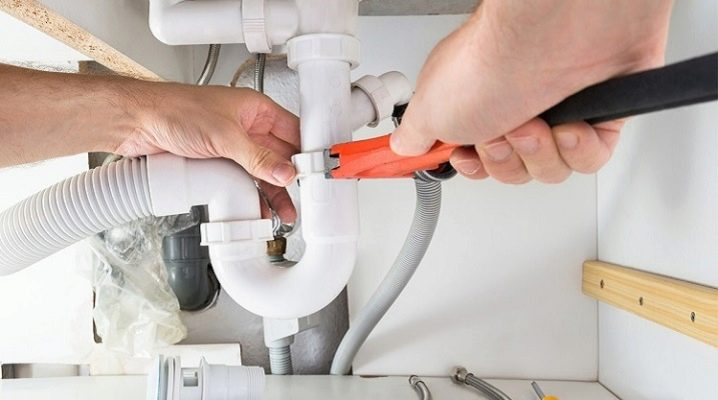
A siphon is a special device that provides reliable protection against the ingress of sewage waste into living quarters, as well as clogging of pipes with mechanical microparticles. Siphons of different types have their own characteristics, and each has its own advantages and disadvantages.


What it is?
A sink siphon is a device that serves to drain excess water. You can install it in the tightest space. It allows you to eliminate unpleasant odors without letting them into the room. Connecting such a device will not be difficult. Before purchasing this or that model, you should carefully consider the structure of the material of its manufacture. Most often it is a corrugation - a flexible PVC hose (sometimes with the addition of metal alloys).

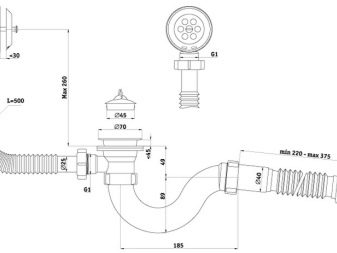
The main elements of a corrugated siphon.
- Pipe. It can consist of several elements that are connected to a single point.
- Water "castle". In a corrugated structure, it is formed due to the fact that the pipe is bent during installation.
- Gaskets and couplings.
- Clamp clamps.
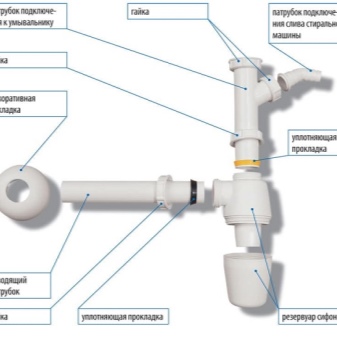
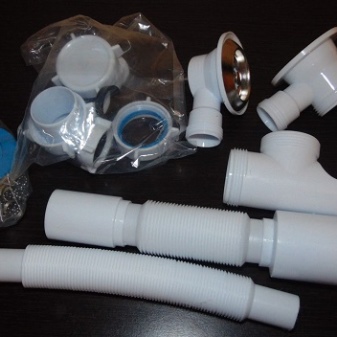
The advantages of this model:
- is inexpensive;
- it is easy to transport and assemble;
- has a compact size;
- can be used in any premises;
- the element is plastic and flexible, can be mounted at any angle.
Among the shortcomings, it is worth noting the fragility of the material, the accumulation of various deposits in the bends over time. Such an element needs preventive cleaning using special chemicals, rinsing with the pressure of running water. When installing, it must be borne in mind that the tube can be easily damaged by piercing and cutting objects, therefore, it is recommended to observe precautions.

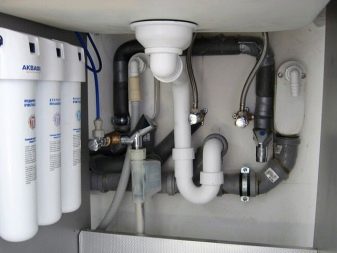
Specifications
The characteristics of siphons may differ depending on what function they perform. The most common devices for draining water are bottle-shaped siphons (commonly called "bottle-shaped"). Such plumbing fixtures compare favorably with the fact that they are easy to clean. Also, various equipment can be easily connected to them. GOST standards for these devices have remained from the times of the Soviet Union, they are simple and reliable in operation.
In recent years, corrugated models have been hitting records in popularity. Their main advantages are simplicity and reliability in operation. Even a schoolboy can assemble a set of such material on his own. The material bends well, it can take on the most complex shapes. Corrugation with metal elements is a durable product that can last for decades. The corrugation also stretches and bends well, which increases its functionality during installation.
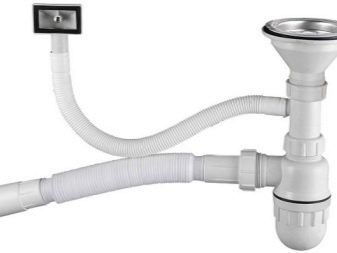
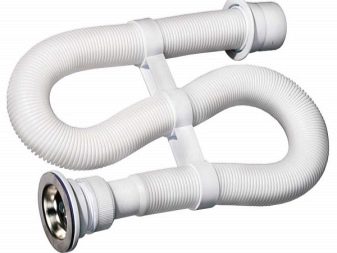
The corrugated siphon made of metal looks stylish, in operation it is distinguished by its strength and rigidity. It does not require additional fasteners - clamps. Such elements are convenient to use in washbasins in bathrooms.
The corrugation is used by bottle-type siphons and successfully replaces a rigid pipe, simplifies connection to the sewer. Such a device has all the positive qualities of siphons.
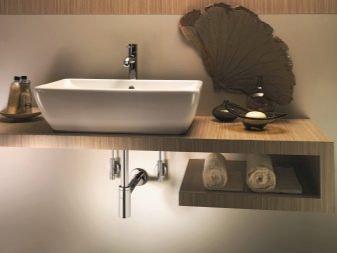
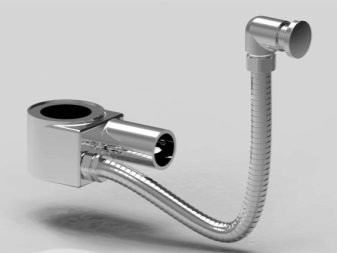
Design
The principle of operation of the siphon is simple. It is a curved tube in which water is present.It prevents the ingress of odors from the sewage into the dwelling. Siphons come in many different types:
- corrugated;
- tubular;
- bottle washbasins;
- with a water seal;
- with two taps;
- with a non-return valve.
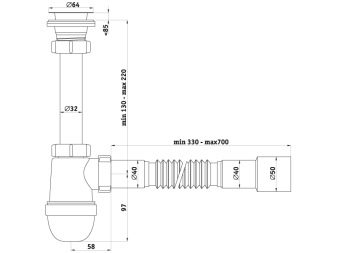
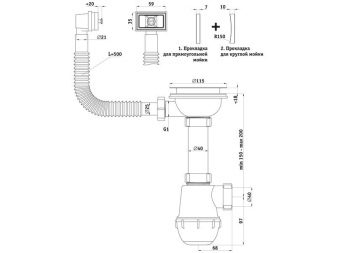
The first is a U- or S-shaped pipe. Also, such devices can be made from different materials, but most often from metal and plastic.
The most advanced designs are dry-seal siphons. (non-return valve). They were invented back in the 90s. They are not very popular, although they deserve it. In such equipment, there is a check valve, which forces the flow to tend in one direction only. After it ends, a special locking element is triggered in the pipe, which blocks the pipe, preventing odors from entering the home. Sometimes automatic siphons are placed in the bathtub, which regulate the drains from the dishwasher or washing machine. If water is used at too high a temperature, then metal siphons should be installed.


Types and their purpose
In mechanical siphons, the overlap of the drain holes is adjustable without the use of any automatic devices. The automatic drain is controlled by a microprocessor. The system has a relay that monitors the water temperature and maintains it at the desired level. In the shower tray, the siphon acts as a "lock". The element provides the following functions:
- stable drainage of dirty water;
- elimination of possible odors from the sewer.


Most often, models for a shower stall are equipped with special locking devices that allow you to draw water in the sump. The drain hole allows water to flow out through the elbowed sewer pipe. There is a special "click clack" system that allows you to close the drainage water and actually acts as a plug. It works by pressing a lever. The valve itself is located inside the drain outlet.
The siphon in the form of a pipe is produced in the following configuration:
- U-shaped;
- S-shaped.
There is a special water seal in the upper part. There is a hole at the bottom that makes it easy to clear the blockage.
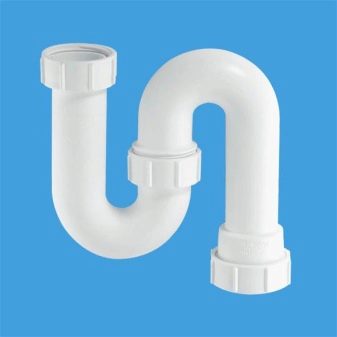

The S-shaped siphon is made of PVC pipe, which easily takes almost any shape.
In a confined space, such a pipe is very functional. The negative side of such a connection is that it can clog up rather quickly and is not as durable as other types of siphons.
The optimal view for a pallet is a bottle siphon. Its very construction creates a reliable natural "lock". The negative side of such a connection is its rather large size. For bottle-type siphons, pallets from 20 cm in height are required. The advantage of such a device is ease of installation.

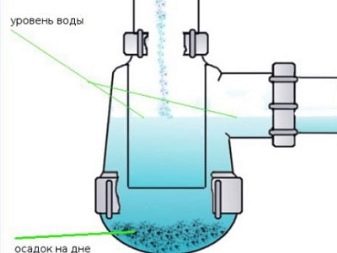
When buying a dishwasher siphon, remember that the material of its manufacture will be "attacked" daily by hot water mixed with fat and chemicals. The material must withstand high temperatures (up to 75 degrees). For such a mechanism, at least two taps are required. Concealed structures are installed in the wall, a special niche is made for this. A closed view has a lot of space. In the event that the unit has a side outlet, it can be placed close to the wall.
When considering different models of siphons for kitchen sinks, the size of the nozzle should be taken into account. The larger its diameter, the less chance of clogging. It is better to put rubber gaskets, they are more reliable. The product must be free from defects. Products from well-known manufacturers may cost more, but they will last much longer. Nowadays, siphons are most often bought, into which antibacterial compounds can be added.When buying a sink, it is recommended to pay attention that it has an additional drain, this protects the sewage system from clogging and overflow.
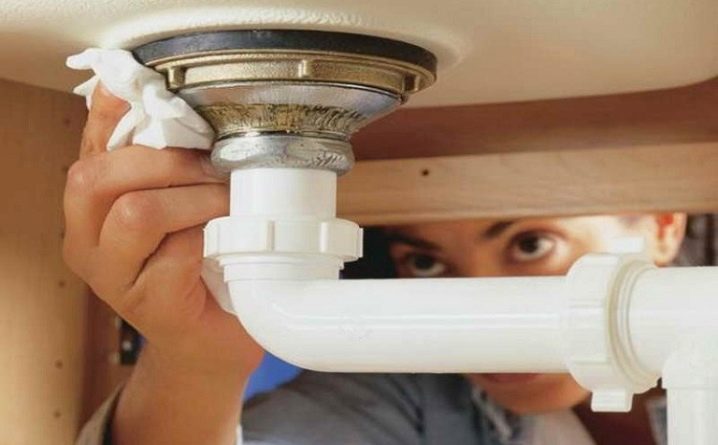
Flat
The flat siphon takes up little space. This element is strong and durable. It works according to the standard principle: water enters the drain, passes through the pipe. This type of siphon effectively protects against unwanted odors from the sewer. Consists of the following elements:
- protective lattice screen;
- pad;
- pipe branch;
- clamps and couplings;
- durable body;
- branch and adapter.
Flat siphons are made of plastic, so they are durable and low in price. It is possible to connect additional elements to them. An important advantage of such siphons is that they are easy to clean and can be placed in small rooms.


Pipe
Pipe siphons are most often installed in bathrooms and toilets. The design of the plumbing device is easily clogged, so if such a siphon is installed in the kitchen, this is not the best option. It is rather difficult to maintain such elements.
The advantage of pipe elements is their aesthetic appeal and ease of installation. The materials for their production are very different, the warranty period of many of them is several decades.

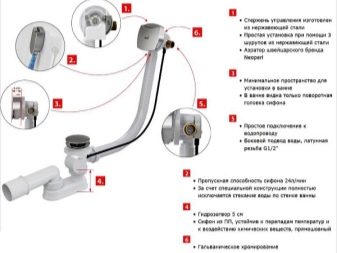
Straight-through
A straight-through siphon is installed under the sink or sink in the bathroom. This design allows for increased throughput, at the same time, it is compact and can be located in the narrowest spaces.
The direct-flow siphon is designed for a washbasin and has a relatively small diameter. Sometimes there are several branches in the design, which are combined by 2-3 water seals. Almost all modern sinks have special overflows, in which there are small outlets for draining excess water. The complete set of rectangular siphons also includes an overflow, which has a rectangular tip.
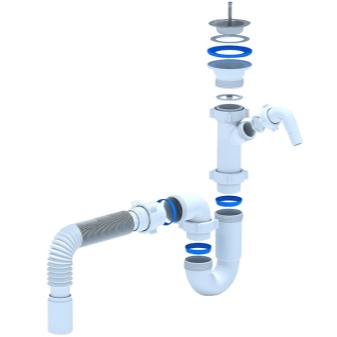
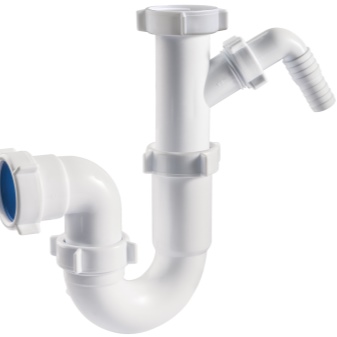
Wall-mounted
A wall-mounted siphon is a plumbing fixture that is installed between the pipes and the toilet. In order for it to work correctly for many years, some rules must be followed during its selection. This type of siphon fits snugly against the wall and is mainly used for washbasins and washing machines. The wall-mounted siphon has a long pipe that connects the sink hole to the sewer pipe.
In the Soviet years, such products were made of cast iron; now, various alloys (chrome, brass) are most often used for this. The latter metal is more durable and resists high humidity better. Chrome-plated steel can only serve for a few years, as it is highly susceptible to corrosion. A couple of decades ago, a PVC siphon quickly deteriorated from high temperatures. Now the situation has changed, as manufacturers began to produce high-strength plastics, which in their characteristics are not much inferior to steel, moreover, it does not deteriorate from corrosion.

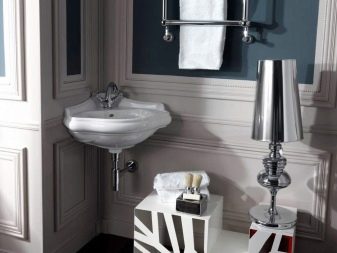
It is recommended to buy polypropylene siphons. They are very durable and their purchase is justified in terms of price / quality ratio.
Advantages of the wall-mounted siphon:
- looks aesthetically pleasing;
- takes up a minimum of space;
- easy to install and operate.
But it has an inconvenient pipe that is not always convenient to clean. Also, sometimes fitting equipment requires high professionalism when the parameters of the bathroom are too small. The advantages of a wall siphon are incomparably more, this can explain its great popularity.
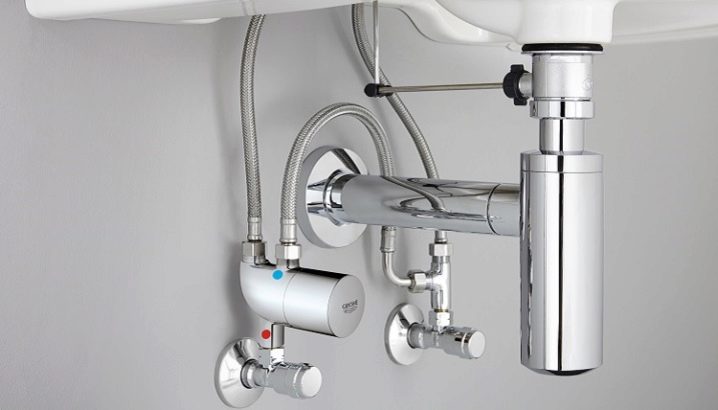
Floor
The floor siphon is placed under the bathroom. The element has a tee with which the pipe is attached to the siphon. This arrangement makes it possible to make installation in any chosen direction. The pipe diameter of the device is 42 mm.
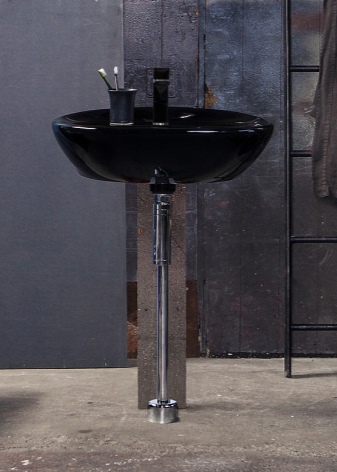
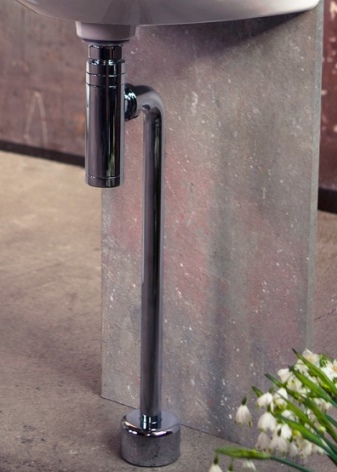
Two-turn
A double-turn siphon is one of the varieties of diverting communications. The design consists of a bent tube, in which there is a horizontal drain after the elbow. The upper unit is called the “foot valve” and receives waste water. As a rule, there is a grill on the branch pipe, which protects the pipeline from blockages. There is also a knee that can be changed. This is where dirt usually accumulates. The siphon is connected through a branch to the city sewerage system.

There are several types of double-turn siphons.
- Plastic does not rot or rust, easy to assemble. It can work without additional spacers, since the material has a high coefficient of linear tension.
- Chromed elements are made from various alloys. Time works against them - in a humid environment they inevitably oxidize, lose their attractive appearance, but do not rust like metal.
- Cast iron double-turn siphons are difficult to install, but they can serve for many years. In the joints during installation, additional gaskets should be installed. Their advantage is that they can withstand high pressures and temperatures. Such equipment was installed in the last century and is now almost never used.
- Knee siphons can be found in various plumbing fixtures. With their help, sewage water is diverted. They function as water locks. There is always water in the bend of the pipe, which protects against odors from the sewer system and prevents pathogenic bacteria from entering the home.
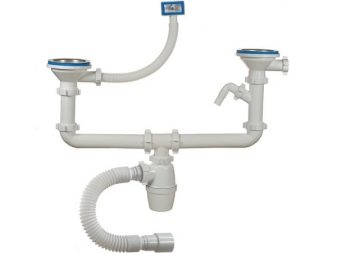
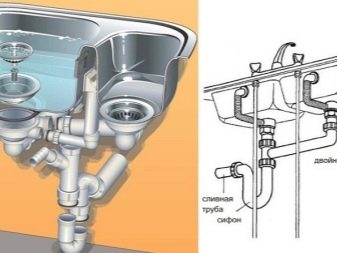
Manufacturing materials
A siphon for a bathroom or sink can be made of both PVC and cast iron, there is no big difference here. These materials are now of high quality, so even a plastic siphon can last 50 years without any complaints.
A metal siphon under the sink in the bathroom is sometimes made to order, but you can find it by looking at the catalogs of famous manufacturers. Most often, design issues are resolved here, when the siphon must correspond to the general aesthetic concept.
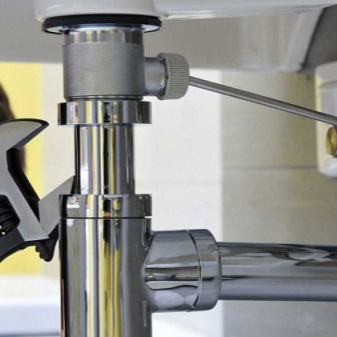

Popular manufacturers
The most popular siphon manufacturers are:
- Ani-Plast;
- HL;
- Blanco;
- McAlpine;
- Hepvo.
One of the most famous siphon companies in the world - MacAlpine... The company has been operating for a little over 60 years, based in Scotland. It began its activity with PVC siphons, innovative for those times. MacAlpine releases innovative designs almost every year.
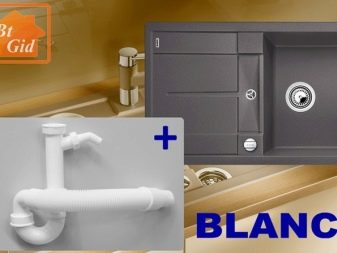

Manufacturer Hepvo (Germany) produces siphons for such devices:
- shells;
- baths;
- filters.
Another well-known company from Germany is Blanco... Siphons from this company are not cheap, the models use new composite materials. The products are distinguished by their reliability and aesthetic appeal. Some of the best siphons are produced by a Russian manufacturer Ani-Plast... Their devices are inexpensive, but they are reliable in operation. The company is rapidly gaining recognition and entering the international market.
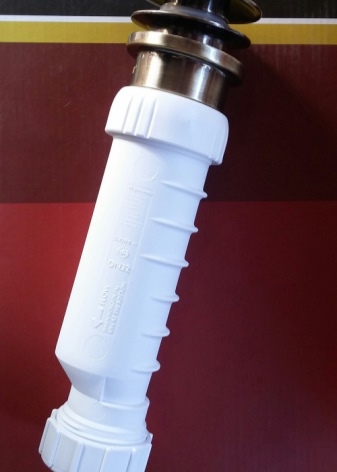

Selection Tips
Choosing a compact corrugated siphon, there are a number of factors to consider.
- The size. The product should fit without any difficulty in the narrow space under the sink. It is important to know the diameter of the outlet pipes, which should be commensurate with the diameter of the drain pipe. If there is a discrepancy in size, consultation with a professional with extensive experience is required.
- Equipment. The set with the siphon must include all the main elements (branch pipe, fasteners, gaskets).
- Number of bends. Often it is necessary to connect various devices to the siphon, so space for additional connections is necessary. For example, if the sink has two compartments, then you will have to purchase a siphon with at least two nozzles. If there is a hole in the sink that protects it from overflowing with water, then you will have to purchase a siphon with an overflow.Such little things reliably protect neighbors from flooding in the event of a blockage.
- Manufacturer. Russian manufacturers produce more and more quality products every year. The price / quality ratio always matters, but the best Russian firms have lately not been inferior to foreign manufacturers.
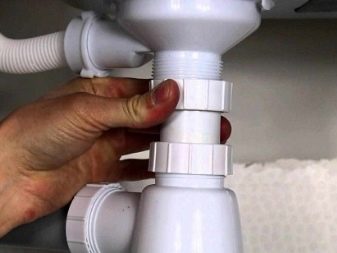

When buying, you should pay attention to the warranty and the absence of defects on the products in order to avoid unexpected leaks. It is best to choose pipes that are smooth from the inside, it is easier to work with them during cleaning. After dismantling the equipment, it is imperative to plug the sewer inlet with an old rag. All elements during operation should be degreased using alcohol.
When buying, you should immediately choose the desired diameter, which will correspond to the diameter of the sewer hole Is the safest way to avoid leaks. It is best to buy a sink together with a sink in the complex. You can install the device yourself, but you should only carefully read the manufacturer's recommendations, check the model for faults and defects when buying.

Installation features
Corrugated siphon It's easy to put:
- rubber gaskets are placed on the edge of the hole, while a water-repellent silicone sealant is used;
- after that, a mesh is installed in the hole, as well as the neck of the siphon;
- the connection is made using a special screw (it is included in the kit);
- the corrugation itself is connected to the neck with a nut;
- the washing machine is connected using a special tap;
- after that, the corrugation is bent in the shape of the letter N, fastened using clamps;
- at the bottom, the socket is attached to the sewer pipe.
After installation, the system is checked for leaks. This can be done by opening the tap and putting a napkin under the siphon - this way you can notice traces of moisture. After successful passing of the tests, the napkin should be dry, there should be no foreign odors.

Such an operation does not require high qualifications; even a beginner can carry it out. Such a simple device will reliably protect the home. In this case, you will not need to spend extra money on the installation of expensive imported models.
Tools for the job:
- screwdriver;
- sealant;
- pliers;
- scissors for metal;
- nippers;
- Scotch;
- PVA glue.

Step-by-step instruction:
- before doing the installation, carefully read the manufacturer's instructions;
- a PVC lattice is placed in the hole;
- a rubber gasket is placed on the branch pipe;
- the branch pipe itself is pressed against the drain, a large screw is tightened;
- the siphon itself joins;
- a washer is placed on the branch pipe, installed in the siphon bell for an acceptable length;
- the nut is tightened.
The last phase of installation is testing. Place a container under the drain, open the tap at full power. If there are leaks, then local dismantling should be done, check and how tightly the gaskets adhere to the elements.
In the next video, you are waiting for the assembly and installation of a bath siphon.













The comment was sent successfully.